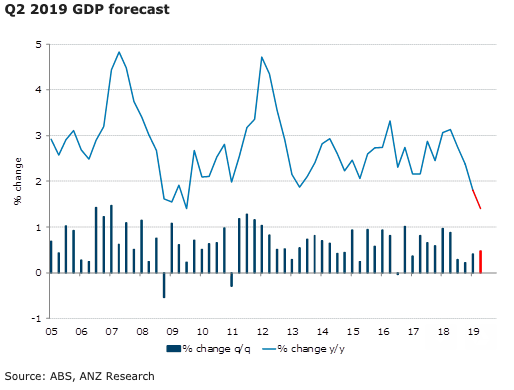After the release of key partial indicators this week, Australia’s gross domestic product (GDP) for the second quarter of this year is expected to rise 0.5 percent q/q. This would see annual growth edge down to 1.4 percent which would be the slowest pace since the GST, according to the latest report from ANZ Research.
The headline growth number, however, belies the underlying weakness in the economy. Private demand looks to have fallen by 0.3 percent q/q in Q2 following a similar fall in Q1, to be down 0.6 percent over the year.
The mainstay of economic growth at the moment is public demand, which looks to have contributed 1.6ppt to annual growth. This highlights the difficulty for the government and the RBA, in generating measures to support the economy when public spending is already the key driver of growth.
GDP growth, at +0.5 percent q/q and +1.4 percent y/y, would be lower than the RBA expected a month ago. In its August Statement on Monetary Policy, the Bank’s June forecast was +1.7 percent y/y requiring growth of 0.8 percent q/q in Q2.
For the RBA, the surprise weakness looks to have come from the private domestic economy. In particular, dwelling investment and business investment both look to be significantly weaker than the RBA anticipated.
In the GDP report tomorrow, the focus will once again be on the household indicators – consumption and income. Soft retail sales volumes (+0.2 percent q/q) point to relatively modest growth in consumer spending.
While retail spending accounts for only around 30 percent of consumption, the earlier fall in house prices and ongoing soft income growth will have weighed on consumer spending in the quarter. Preliminary data suggest this is likely to pick up a little, but continue to show only modest growth, the report added.
The Q2 GDP data is somewhat dated. The second half of the year should see much better consumer spending reflecting the stimulus coming from lower interest rates and tax refunds. Rising house prices may also have an impact.
But the Q2 GDP report is likely to show that the starting point was lower than the RBA expected. And the Bank’s concerns over the international backdrop would only have risen since the August meeting.
"While the RBA looks likely to keep rates on hold at its board meeting today, we expect a follow up cut in coming months. Our view is that the GDP data will likely confirm the Bank’s thinking that the economy needs some extra stimulus to run faster, to push the unemployment rate down, and eventually generate inflation closer to the target," ANZ Research further commented in the report.



 RBI Cuts Repo Rate to 5.25% as Inflation Cools and Growth Outlook Strengthens
RBI Cuts Repo Rate to 5.25% as Inflation Cools and Growth Outlook Strengthens  Dollar Weakens Ahead of Expected Federal Reserve Rate Cut
Dollar Weakens Ahead of Expected Federal Reserve Rate Cut  Asian Currencies Steady as Rupee Hits Record Low Amid Fed Rate Cut Bets
Asian Currencies Steady as Rupee Hits Record Low Amid Fed Rate Cut Bets  FxWirePro: Daily Commodity Tracker - 21st March, 2022
FxWirePro: Daily Commodity Tracker - 21st March, 2022  U.S. Stocks Rise as Cooler Inflation Boosts Hopes for Fed Rate Cut
U.S. Stocks Rise as Cooler Inflation Boosts Hopes for Fed Rate Cut  BOJ Governor Ueda Highlights Uncertainty Over Future Interest Rate Hikes
BOJ Governor Ueda Highlights Uncertainty Over Future Interest Rate Hikes  Austria’s AA Credit Rating Affirmed as Fitch Highlights Stable Outlook
Austria’s AA Credit Rating Affirmed as Fitch Highlights Stable Outlook  European Oil & Gas Stocks Face 2026 With Cautious Outlook Amid Valuation Pressure
European Oil & Gas Stocks Face 2026 With Cautious Outlook Amid Valuation Pressure  China Urged to Prioritize Economy Over Territorial Ambitions, Says Taiwan’s President Lai
China Urged to Prioritize Economy Over Territorial Ambitions, Says Taiwan’s President Lai  IMF Deputy Dan Katz Visits China as Key Economic Review Nears
IMF Deputy Dan Katz Visits China as Key Economic Review Nears  U.S. Stocks End Week Higher as Markets Anticipate Fed Rate Cut
U.S. Stocks End Week Higher as Markets Anticipate Fed Rate Cut  Trump Meets Mexico and Canada Leaders After 2026 World Cup Draw Amid USMCA Tensions
Trump Meets Mexico and Canada Leaders After 2026 World Cup Draw Amid USMCA Tensions 































